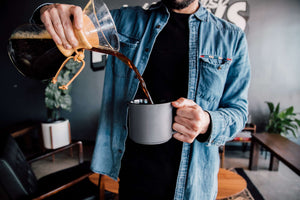Pour-over and drip coffee are both pretty straightforward ways of making barista-quality coffee at home - but which is better?
The reality is that our coffee taste buds vary wildly, so it's probably a matter of personal preference.
Still, if you're stuck on indecision, Hoxton Coffee will run through all the pros and cons, brewing times and equipment needed so you can set your sights on an amazing cup of coffee every day from here on out.
What Is a Pour-Over Coffee?
The pour-over coffee technique dates right back to the inventor of the paper coffee filter, Melitta Bentz, who forever changed how we extract flavour from our favourite beans!
Before Ms Bentz stepped up the coffee-making game, brewers would use old-school cloth filters, which were (needless to say) less than efficient.
When the paper filter came along in 1908, interestingly, the result of an experiment with a page from a kid's schoolbook, the pour-over was born.
It's an effective way to extract big flavour note bangs for your buck, yet it is a simple brewing process anybody can use at home.

Plus Points in Favour of the Pour-Over
The big advantage of pour-over coffee is that you can customise every cup - using different grounds and densities and soaking the coffee for varying times during each brew.
If you're a big fan of black, rich coffee, first check out Proper Strong, and next consider a pour-over since you get those loud flavours, since it takes a little longer for the water to filter through the grounds and into your eagerly awaiting mug.
What Is a Drip Coffee?
Our contender in this contest is the drip coffee - which our friend Ms Bentz was also instrumental in designing!
When we'd gotten used to pour-over filters, a chap called Gottlob Widmann decided to use that idea to engineer an electric drip machine called a Wigomat.
Right up to the 1950s, our parents (or grandparents) were using percolators or pour-over filters, so this was an early invention that brought automated coffee making into our homes.
Machines used disposable filters and made it more accessible to buy an electric coffee machine without the fuss and faff of servicing or taking the device to pieces to clean it.
Plus Points in Favour of the Drip Coffee
Drip coffee is a staple item on most American diner counters, and it's a bit of a retro appliance to have in your kitchen.
These machines (which produce coffee in a somewhat agonising drip-by-drip process) took over from conventional percolators by the 1970s and arguably are the easiest possible way to make coffee.
All you need to do is pour in the water, add a filter and your grounds, and then sit back and wait - patiently! - for your jug to fill.
Differences Between Pour-Over and Drip Coffee
Now onto the nitty gritty and some of the feedback from our Hoxton Coffee Roasters about which home-brew method they prefer - and why!
- Pour-over coffee tastes more flavourful than drip coffee because it takes a bit longer to brew and extracts a greater depth of taste and oil from the coffee grounds. Drip coffee can taste amazing but is a bit smoother and less robust.
- In terms of speed, drip coffee is quicker if you're making a big pot to caffeinate everyone at once! But, you sacrifice a bit of flavour for convenience.
- Drip coffee quality depends on your coffee machine - and, of course, your chosen Hoxton Coffee blend. Pour-overs are more controlled since you can adjust the brewing time to your preferences.
If you're a coffee connoisseur, you're probably going to opt for a pour-over and can pick up cup stands and ceramic drippers or a Chemex if you're after something a bit more stylish.
Drip coffee isn't as refined, but it does do everything for you - invest in a fantastic electric drip coffee machine, and you're good to go.
Once you've made a judgement call, read on for our step-by-step guide to making the perfect pour-over or drip coffee!
How to Make Pour-Over Coffee
There are tons of pour-over stands or devices, which can be cheap and cheerful or pretty costly, so it's up to you what sort of pour-over equipment you'd like.
They all work the same way - you add the filter and grounds in the funnel and then slot this into the space at the top of your pour-over mug or carafe.
Timing is everything!
- First, you should rinse the filter and soak it to stop the paper's taste from getting into your cup.
- Next, you get the coffee to bloom by pouring in your grounds and a small amount of water around the funnel, which releases the flavour.
- Then you pour your hot water from the centre, moving in a circle towards the outside of the filter, never tipping over the edge.
- Wait for the water to drain through, and then repeat!
When you've got a cupful ready to go, remove the filter (watching out for your fingers) and have a sip.

How to Make Drip Coffee
A drip coffee machine has a water reservoir that you'll need to top up before you start brewing - you can use regular tap water; it doesn't need to be pre-heated!
The machine creates pressure and heat, warming the water and filtering it down through the grounds and into your jug.
That's all there is to it - make sure you replace your filter each time. Otherwise, you'll get a dusty, bitter coffee that isn't the best start to the day!
If you're after more insights into competing coffee-making options, please visit our Coffee Blog for advice, expertise and opinion from the Hoxton Coffee specialists.

